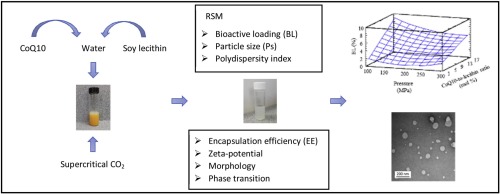Journal of CO2 Utilization ( IF 7.7 ) Pub Date : 2020-01-17 , DOI: 10.1016/j.jcou.2020.01.011 David Villanueva-Bermejo , Feral Temelli

|
Coenzyme Q10 (CoQ10)-loaded liposomes were prepared with soy lecithin utilizing a single step supercritical carbon dioxide (SCCO2) method, which did not require the use of organic solvents, buffers or surfactants. The effects of pressure, temperature, pressurization rate and CoQ10-to-lecithin ratio on bioactive loading (BL), particle size (Ps) and polydispersity index (PdI) were investigated and modeled by response surface methodology (RSM). Pressure and concentration of CoQ10 had a great influence on the three responses. High pressures led to lower BLs, but also particles with smaller Ps and PdI. High concentrations of CoQ10 allowed obtaining higher BLs and lower PdI, but also higher Ps. High pressurization rates were needed to obtain high BLs, but, in contrast, it also led to higher PdIs. Temperature had a positive influence only on the PdI. The optimum conditions predicted by the model to simultaneously maximize the BL and minimize the Ps and PdI were 30 MPa, 40 °C, 6 MPa∙min−1 and 17 mol% CoQ10 (BL of 4.2 %, Ps of 177 nm and PdI of 0.313). Furthermore, encapsulation efficiencies between 87.6–99.7 % were achieved and semi-spherical stable particles (zeta potential ≈ −70 mV) were formed. Differential scanning calorimetry indicated a potential loss of crystallinity upon the encapsulation of CoQ10 into the liposomes. The findings reveal the great potential of this SCCO2 method for the encapsulation of CoQ10 in liposomes.
中文翻译:

使用超临界二氧化碳优化脂质体中辅酶Q10的封装
利用一步法超临界二氧化碳(SCCO 2)和大豆卵磷脂制备负载辅酶Q10(CoQ10)的脂质体)方法,不需要使用有机溶剂,缓冲液或表面活性剂。研究了压力,温度,加压速率和辅酶Q10与卵磷脂的比例对生物活性负荷(BL),粒度(Ps)和多分散指数(PdI)的影响,并通过响应表面方法(RSM)进行了建模。辅酶Q10的压力和浓度对这三个响应有很大影响。高压导致较低的BL,但也导致Ps和PdI较小的颗粒。高浓度的辅酶Q10允许获得更高的BL和更低的PdI,但也可以获得更高的Ps。需要高加压速率以获得高BL,但是相反,它也会导致更高的PdI。温度仅对PdI有积极影响。该模型预测的同时最大化BL和最小化Ps和PdI的最佳条件是30 MPa,40°C,-1和17 mol%的CoQ10(BL为4.2%,Ps为177 nm,PdI为0.313)。此外,实现了87.6-99.7%的封装效率,并形成了半球形稳定颗粒(ζ电势≈-70 mV)。差示扫描量热法表明在将CoQ10包封到脂质体中时结晶度的潜在损失。这些发现揭示了这种SCCO 2方法在脂质体中包裹辅酶Q10的巨大潜力。


























 京公网安备 11010802027423号
京公网安备 11010802027423号